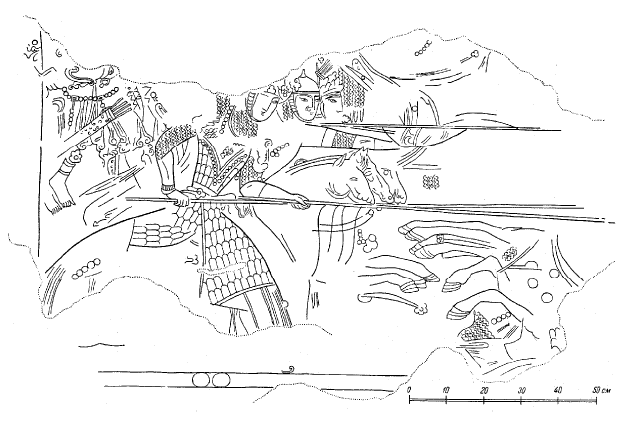
Amazon Audible Gift Memberships
Sogdian Mural in House III/6, Panjakent, 6th-8th Centuries.
State Hermitage Museum, St Petersburg.

Upper drawing of Fig. 37. Pendzhikent. Wall painting.


Pendzhikent
On the basis of the excavations in Pendzhikent (fig. 35; 96, 1) (near the present-day city under the same name in north-western Tajikistan), one can conclude that each living building in the early medieval town had a plan determined by the desires and capacities of the owner. The housing in design and decor somehow reminds of the rulers palace. The technical level of construction works was in fact similar to the representation of different social strata. In the 5th - 8th centuries AD mud-brick and pakhsa masonry increased and in Tokharistan, Sogd, Ferghana, and Ustrushana there was a shift to mud-bricks with rectangular shape. A building with three floors of the 6th century AD, intended for a permanent garrison which is situated in eastern wall of fortress, is related to the time of the Hephthalites in Pendzhikent.
The wall paintings of Pendzhikent (fig. 37; 38) are considered as depicting realistic characters and are the source of opinions on the ethnic composition of the population. According to A. Belenitsky, representatives of three ethnic groups are shown in these paintings - Sogdians, Turks and Kushan-Hephthalites. Ilyasov discussing the tamgha of the Pendzhikent ruler’s coins of the second half of 7th century, Gamaukyan (or Hamaukyan), notes that these are most likely of Chionite-Hephthalite origin. Based on the material from Pendzhikent a ceramic sequence was established covering the 5th century to the first half of the 8th century AD (fig. 36). The defined periods are: 5th century; end of 5th century – beginning of 6th century; 6th – beginning of 7th century; middle of 7th century; end of 7th - 8th century; and first quarter of 8th century AD.
Source: The Hephthalites: Archaeological And Historical Analysis by Aydogdy Kurbanov
The foreground horseman is referenced as figure 434 in The military technology of classical Islam by D Nicolle
434. Fresco from Piandjikent House III/6, 7th-8th centuries AD, Transoxanian, Hermitage, Leningrad (Aka S, Yaku).